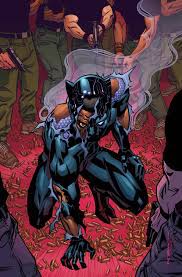Thursday Comics Hangover: Coates check
I have to admit something: I loved the first issue of Ta-Nehisi Coates's Black Panther, but the series has largely lost my interest in the intervening year-and-a-half. That first issue was a perfect balance between pop-culture philosphy and superhero action, and Coates seemed to be attempting a more stylish version of a text-heavy style of comics writing that we haven't seen in mainstream comics since the 1980s.
But gradually, over the next few issues, Coates's writing went from wordy to overindulgent to bloated. Long stretches would happen where people would talk in self-important prose and all the important story beats seemed to be happening off-panel. The recap pages would contain more palace drama than the actual comics pages.
And to cap it all off, Brian Stelfreeze, the artist who started Black Panther with Coates, seemed to entirely disappear. Stelfreeze has always had difficulty hitting a monthly deadline, but this book used so much of his visual language that when he stopped drawing the title, the characters seemed to lose their motivation with him. I ordinarily adore Chris Sprouse, the artist who has taken Stelfreeze's place, but Sprouse's superheroic figures, who always seem ready to leap off the page their impossible musculatures and lantern jaws, feel badly mismatched with Coates's action-free scripts.

All that said, the latest issue of Black Panther, #16, is the most exciting issue in a long time. In just a few pages, Coates manages to reinvigorate a background character from the Marvel Universe in a way that feels entirely authentic and thought-provoking, yet still true to the character. The few scenes with this character combine social commentary, some fun writing, and a genuine passion for the Marvel Comics framework.
But it's not enough to salvage the whole issue. Back-up characters appear and disappear with no explanation. The story wants to raise stakes without actually investing in building the drama, and Coates can't seem to find a working rhythm for the book.
Perhaps Black Panther reads differently in trade paperback; it's possible that it flows better when given the same attention one would apply to a novel. But as a monthly comic, it's consistently the least interesting book in the stack I bring home from the comic shop. The great promise of that first issue feels squandered.